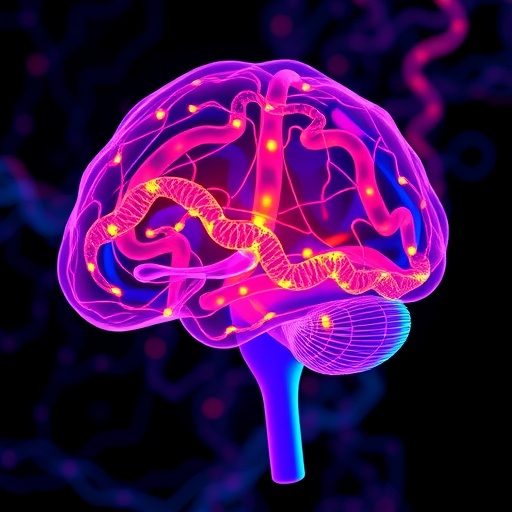In an unprecedented exploration of brain biology, researchers have mapped the hippocampal spatial proteomic signature in male and female mice, targeting an early Alzheimer’s disease model. The study conducted by Contreras et al. reveals critical insights into the neurochemical landscapes that emerge in the early stages of Alzheimer’s, potentially opening new avenues for understanding disease progression and intervention.
Alzheimer’s disease (AD) poses a significant challenge to global health, affecting millions worldwide. As a neurodegenerative disorder, it is characterized by cognitive decline and memory loss. Understanding the mechanisms that underlie this ailment is paramount for developing effective therapeutic strategies. The researchers embarked on this journey by investigating the spatial distribution of proteins within the hippocampus, a region deeply implicated in memory and cognition.
Proteomics, the large-scale study of proteins, is a critical field in biomedical research that provides insights beyond traditional genomics. By mapping the specific proteins present in the hippocampus of male and female mice models of early AD, the researchers aimed to identify distinct patterns that could be linked to sex differences in disease manifestation. The findings promise to enhance our understanding of how gender may influence the onset and progression of Alzheimer’s.
The innovative approach utilized by the researchers involved advanced imaging technologies and sophisticated bioinformatics techniques. By combining these methodologies, they were able to obtain a high-resolution spatial mapping of the proteomic landscape within the hippocampus. This endeavor demands meticulous attention to detail, as even slight variations in protein levels can indicate significant underlying biological processes.
One of the most intriguing aspects revealed by this study was the stark contrast in protein expression between male and female mice in the context of early Alzheimer’s. The authors discovered that certain proteins, which are crucial for neuronal health and synaptic plasticity, were differentially expressed based on sex. This discovery could elucidate potential reasons for the observed variances in Alzheimer’s symptoms and progression between genders.
Moreover, the implications of this research extend beyond mere academic curiosity. The identification of specific protein signatures could pave the way for biomarkers that allow clinicians to predict the likelihood of Alzheimer’s onset based on sex. Such advancements could transform the clinical landscape, where personalized medicine tailored to an individual’s biological profile becomes the standard of care.
Aside from the protein mapping, the study also delved into the potential implications of these findings on therapeutic interventions. If certain proteins were found to be modifiable, treatments could be developed to upregulate beneficial proteins or downregulate those that contribute to neurodegeneration. This precision approach represents a significant leap forward from current methodologies, where therapies often apply a one-size-fits-all mentality.
Another compelling facet of this research is its potential intersection with the burgeoning field of neuroepigenetics. The researchers noted that the expression of proteins is not solely controlled by genetic sequences but can also be influenced by epigenetic factors, including environmental influences and individual lifestyles. This revelation could lead to a broader understanding of how lifestyle modifications may mitigate Alzheimer’s risk based on an individual’s unique proteomic profile.
The findings from Contreras et al. are poised to inspire further research into the sex-specific mechanisms of Alzheimer’s disease. Unraveling these pathways could lead to the development of tailored therapies that not only target the disease effectively but also account for the biological differences that exist between sexes. These efforts underscore the need for rigorous investigations that encompass diverse biological factors, including sex, age, and genetic predispositions.
One of the barriers to progress in Alzheimer’s research has been the reliance on predominantly male models, which has obscured our understanding of how the disease uniquely affects women. This study challenges that convention by shining a light on sex differences and emphasizing that both male and female perspectives are crucial for a comprehensive understanding of disease dynamics.
Furthermore, the researchers advocate for more inclusive experimental designs in future studies. It is essential that new research endeavors recognize the complexity and multifactorial nature of Alzheimer’s disease and its interactions with sex-related factors. This paradigm shift will not only illuminate the nuances of Alzheimer’s progress but also foster advancements in therapeutic approaches and preventative strategies.
As we stand at the forefront of brain research, the implications of the study conducted by Contreras et al. extend far beyond the confines of laboratory walls. The integration of proteomics into Alzheimer’s research promises to revolutionize our understanding of the disease, instigating a shift towards a more nuanced and targeted approach to treatment.
In conclusion, the detailed mapping of the hippocampal spatial proteomic signature in male and female mice presents a powerful tool for deciphering the complexities of Alzheimer’s disease. With its focus on sex differences, this study not only enhances our understanding of the disease mechanisms but also opens up potential pathways for deriving innovative therapeutic strategies.
Subject of Research: Mapping the hippocampal spatial proteomic signature in male and female mice in the context of early Alzheimer’s disease.
Article Title: Mapping the hippocampal spatial proteomic signature in male and female mice of an early Alzheimer’s disease model.
Article References: Contreras, A., Jiménez-Herrera, R., Djebari, S. et al. Mapping the hippocampal spatial proteomic signature in male and female mice of an early Alzheimer’s disease model. Biol Sex Differ 16, 36 (2025). https://doi.org/10.1186/s13293-025-00697-5
Image Credits: AI Generated
DOI:
Keywords: Alzheimer’s disease, Proteomics, Hippocampus, Sex differences, Neurodegeneration, Biomarkers, Personalized medicine.
Tags: Alzheimer’s disease therapeutic strategiesbrain biology researchcognitive decline and memory lossearly Alzheimer’s disease modelgender influence on Alzheimer’s diseaseHippocampal proteins in Alzheimer’s diseaseinsights into neurodegenerative disorders.mapping proteins in the hippocampusneurochemical landscapes in Alzheimer’sproteomics in biomedical researchsex differences in Alzheimer’s progressionspatial proteomics in neurodegeneration





